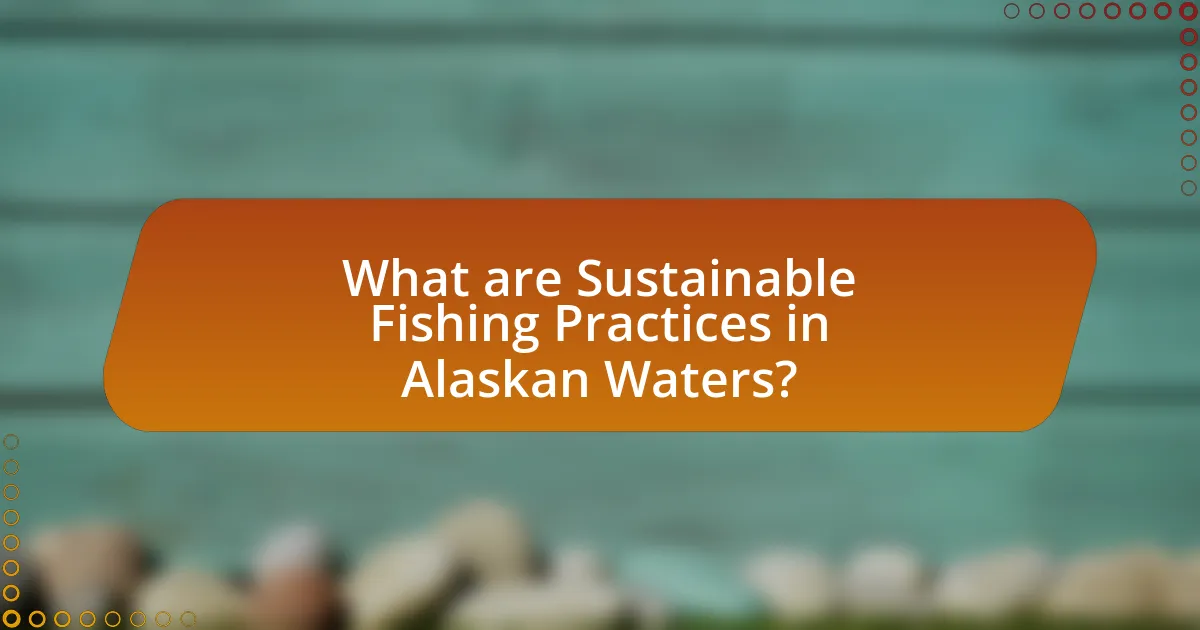Sustainable fishing practices in Alaskan waters are essential for maintaining healthy fish populations and preserving marine ecosystems. These practices include implementing scientifically informed catch limits, using selective fishing gear to reduce bycatch, and adhering to seasonal closures to protect spawning fish. The article explores the importance of these practices, the ecological impacts of unsustainable fishing, and the principles that guide sustainable management. It also discusses the role of habitat protection, community involvement, and the challenges faced in implementing sustainable practices, such as climate change and economic pressures. Additionally, the article highlights the benefits of sustainable fishing for local communities and the actions individuals can take to support these efforts.

What are Sustainable Fishing Practices in Alaskan Waters?
Sustainable fishing practices in Alaskan waters include methods that ensure fish populations remain healthy and ecosystems are preserved. These practices involve implementing catch limits based on scientific assessments, using selective fishing gear to minimize bycatch, and adhering to seasonal closures to protect spawning fish. For instance, the North Pacific Fishery Management Council sets quotas for various species, which are informed by stock assessments to prevent overfishing. Additionally, the use of gear like circle hooks and fish traps helps reduce the capture of non-target species, thereby supporting biodiversity. These measures are crucial for maintaining the long-term viability of fish stocks and the overall health of marine environments in Alaska.
Why are Sustainable Fishing Practices important in Alaskan Waters?
Sustainable fishing practices are important in Alaskan waters because they ensure the long-term health of fish populations and the marine ecosystem. Overfishing can lead to the depletion of key species, disrupting the balance of the ecosystem and affecting biodiversity. For instance, Alaska’s fisheries, which contribute significantly to the state’s economy, rely on sustainable practices to maintain stocks of species like salmon and halibut. According to the North Pacific Fishery Management Council, sustainable management has allowed for consistent harvest levels while protecting habitats, demonstrating that these practices are essential for both ecological balance and economic stability.
What ecological impacts do unsustainable fishing practices have?
Unsustainable fishing practices lead to significant ecological impacts, including the depletion of fish populations and disruption of marine ecosystems. Overfishing reduces the numbers of target species, which can result in the collapse of local fisheries, as seen with the Atlantic cod, where populations fell by over 90% due to excessive fishing. Additionally, unsustainable methods such as trawling can damage seabed habitats, affecting biodiversity and the overall health of marine environments. This disruption can lead to imbalances in the food web, as predator-prey relationships are altered, further threatening species survival and ecosystem stability.
How do sustainable practices contribute to marine biodiversity?
Sustainable practices contribute to marine biodiversity by ensuring the long-term health of aquatic ecosystems and preventing overfishing. These practices, such as catch limits, selective fishing gear, and habitat protection, help maintain fish populations and their habitats, which are crucial for the overall balance of marine life. For instance, the implementation of the Magnuson-Stevens Fishery Conservation and Management Act in the United States has led to the recovery of several fish stocks, demonstrating that regulated fishing can enhance biodiversity. Additionally, sustainable practices reduce bycatch and minimize damage to marine habitats, further supporting diverse marine species.
What are the key principles of Sustainable Fishing Practices?
The key principles of sustainable fishing practices include maintaining fish populations at healthy levels, minimizing environmental impact, and ensuring the livelihoods of fishing communities. Healthy fish populations are achieved through regulated catch limits, which prevent overfishing and allow stocks to replenish. Minimizing environmental impact involves using fishing methods that reduce bycatch and habitat destruction, such as selective gear and practices that avoid sensitive ecosystems. Additionally, sustainable fishing practices support the economic viability of fishing communities by promoting fair trade and responsible management of resources, ensuring that local economies can thrive while preserving marine biodiversity. These principles are essential for the long-term health of both fish populations and the ecosystems they inhabit.
How does catch limit regulation work in sustainable fishing?
Catch limit regulation in sustainable fishing establishes a maximum quantity of fish that can be harvested within a specific timeframe to prevent overfishing and ensure fish populations remain healthy. This regulation is based on scientific assessments of fish stocks, which consider factors such as population size, reproductive rates, and ecosystem health. For example, in Alaskan waters, the North Pacific Fishery Management Council sets annual catch limits for various species, informed by data from stock assessments and monitoring programs. These limits are designed to maintain fish populations at sustainable levels, ensuring long-term viability and ecological balance.
What role does habitat protection play in sustainable fishing?
Habitat protection is crucial for sustainable fishing as it ensures the preservation of ecosystems that support fish populations. Healthy habitats, such as coral reefs, mangroves, and estuaries, provide essential breeding, feeding, and nursery grounds for various fish species. Research indicates that protecting these habitats can lead to increased fish stocks and biodiversity, which are vital for long-term fishing sustainability. For instance, studies have shown that areas with effective habitat protection can experience up to a 30% increase in fish biomass, demonstrating the direct link between habitat health and fishery productivity.
How are Sustainable Fishing Practices implemented in Alaskan Waters?
Sustainable fishing practices in Alaskan waters are implemented through a combination of strict regulations, scientific research, and community involvement. The Alaska Department of Fish and Game enforces quotas and seasonal restrictions to prevent overfishing, ensuring fish populations remain healthy. Additionally, the North Pacific Fishery Management Council utilizes data-driven assessments to manage fisheries sustainably, which includes monitoring stock levels and ecosystem impacts. Community engagement is also vital, as local stakeholders participate in decision-making processes, fostering a sense of stewardship over marine resources. These practices are supported by the Magnuson-Stevens Fishery Conservation and Management Act, which mandates sustainable practices in U.S. fisheries.
What regulations govern sustainable fishing in Alaska?
Sustainable fishing in Alaska is governed by a combination of federal and state regulations aimed at conserving fish populations and their habitats. The Magnuson-Stevens Fishery Conservation and Management Act establishes guidelines for sustainable fisheries management, while the Alaska Department of Fish and Game enforces regulations specific to state waters, including catch limits, seasonal closures, and gear restrictions. These regulations are designed to ensure the long-term viability of fish stocks, with specific measures such as the implementation of annual catch limits based on scientific assessments of fish populations.
How do local communities participate in sustainable fishing efforts?
Local communities participate in sustainable fishing efforts by implementing traditional ecological knowledge and engaging in collaborative management practices. These communities often utilize age-old fishing techniques that promote biodiversity and minimize environmental impact, such as selective harvesting and seasonal fishing restrictions. For instance, in Alaska, Indigenous groups actively manage fish stocks through co-management agreements with state and federal agencies, ensuring that fishing practices align with ecological sustainability. This collaboration is supported by data showing that areas managed by local communities often exhibit healthier fish populations compared to those without local oversight, highlighting the effectiveness of community involvement in sustainable fishing.
What challenges do Sustainable Fishing Practices face in Alaskan Waters?
Sustainable fishing practices in Alaskan waters face significant challenges, including climate change, overfishing, and regulatory complexities. Climate change alters fish migration patterns and affects ecosystem health, leading to reduced fish stocks. Overfishing, despite regulations, continues to threaten certain species, as illegal fishing activities undermine conservation efforts. Additionally, the regulatory framework can be cumbersome, making it difficult for fishers to comply with sustainability standards while remaining economically viable. These factors collectively hinder the effectiveness of sustainable fishing initiatives in the region.
How do climate change and environmental factors affect fishing sustainability?
Climate change and environmental factors significantly impact fishing sustainability by altering fish habitats, migration patterns, and reproductive cycles. Rising ocean temperatures can lead to shifts in species distribution, forcing fish to move to cooler waters, which can disrupt local fishing economies. Additionally, increased ocean acidification affects the health of marine ecosystems, particularly shellfish populations, which are crucial for both biodiversity and commercial fishing. According to a study published in the journal “Nature Climate Change,” overfishing combined with climate change could reduce global fish stocks by 30% by 2050, highlighting the urgent need for adaptive management strategies in fisheries.
What economic pressures challenge sustainable fishing practices?
Economic pressures that challenge sustainable fishing practices include overfishing driven by high demand for seafood, competition among fishers, and the influence of global markets. Overfishing occurs when fish stocks are harvested at rates faster than they can replenish, leading to depletion of species. For instance, the North Pacific Fishery Management Council reported that certain fish populations in Alaskan waters have been overexploited due to increased fishing efforts and market demand. Additionally, competition among fishers often leads to a race to catch as much as possible, undermining conservation efforts. The global seafood market further exacerbates these pressures, as lower prices for unsustainable fish can incentivize fishers to prioritize short-term profits over long-term sustainability.
What are the benefits of adopting Sustainable Fishing Practices?
Adopting sustainable fishing practices provides significant ecological, economic, and social benefits. Ecologically, these practices help maintain fish populations at healthy levels, ensuring the long-term viability of marine ecosystems. For instance, sustainable methods like catch limits and selective fishing reduce overfishing, which has been shown to lead to population recovery in species such as the Pacific cod in Alaskan waters. Economically, sustainable fishing supports local communities by ensuring a stable supply of fish, which can enhance livelihoods and promote tourism. According to the National Oceanic and Atmospheric Administration (NOAA), sustainable fisheries contribute over $200 billion annually to the U.S. economy. Socially, these practices foster community engagement and stewardship of marine resources, leading to better management and conservation efforts. Overall, the adoption of sustainable fishing practices is crucial for preserving marine biodiversity, supporting economic stability, and enhancing community well-being.
How do sustainable practices enhance fish populations?
Sustainable practices enhance fish populations by ensuring that fishing activities do not exceed the reproductive capacity of fish species. For instance, implementing catch limits and seasonal closures allows fish stocks to replenish, leading to healthier populations. Research indicates that areas with sustainable fishing regulations, such as those in Alaskan waters, have seen significant increases in fish biomass and diversity. A study by the National Oceanic and Atmospheric Administration (NOAA) found that sustainable management practices in Alaskan fisheries have led to a 50% increase in the biomass of key species like Pacific cod over the past two decades. This demonstrates that sustainable practices directly contribute to the recovery and maintenance of fish populations.
What economic advantages do sustainable fishing practices offer to local communities?
Sustainable fishing practices offer significant economic advantages to local communities by ensuring long-term fish stock viability, which supports consistent income for fishermen. These practices help maintain healthy ecosystems, leading to increased fish populations and biodiversity, which can enhance local tourism and recreational fishing opportunities. For instance, a study by the National Oceanic and Atmospheric Administration (NOAA) indicates that sustainable fisheries can yield up to 30% more revenue over time compared to overfished stocks, benefiting local economies reliant on fishing. Additionally, sustainable practices often lead to higher market prices for responsibly sourced seafood, further boosting local income.
How can individuals support Sustainable Fishing Practices in Alaskan Waters?
Individuals can support sustainable fishing practices in Alaskan waters by choosing to consume seafood that is certified by organizations such as the Marine Stewardship Council (MSC) or the Aquaculture Stewardship Council (ASC). These certifications ensure that the seafood is sourced from fisheries that adhere to sustainable practices, which help maintain fish populations and protect marine ecosystems. According to the National Oceanic and Atmospheric Administration (NOAA), sustainable fishing practices contribute to the long-term health of fish stocks and the overall marine environment, making informed consumer choices crucial for supporting these initiatives.
What actions can consumers take to promote sustainable seafood choices?
Consumers can promote sustainable seafood choices by selecting seafood certified by reputable organizations such as the Marine Stewardship Council (MSC) or the Aquaculture Stewardship Council (ASC). These certifications indicate that the seafood is sourced from fisheries or farms that adhere to sustainable practices, ensuring the health of marine ecosystems. Additionally, consumers can educate themselves about local seafood options and support fisheries that use sustainable methods, such as those that avoid overfishing and minimize bycatch. Research shows that consumer demand for sustainable seafood can influence market practices, leading to more responsible fishing and aquaculture operations.
How can advocacy and education contribute to sustainable fishing efforts?
Advocacy and education play crucial roles in promoting sustainable fishing efforts by raising awareness and influencing policy changes. Advocacy groups work to protect marine ecosystems by lobbying for regulations that limit overfishing and promote responsible fishing practices. For instance, organizations like the Marine Conservation Society have successfully campaigned for sustainable seafood sourcing, leading to increased consumer awareness and demand for responsibly caught fish. Education initiatives, such as community workshops and school programs, inform fishers and the public about sustainable practices, the importance of biodiversity, and the long-term benefits of maintaining healthy fish populations. Research indicates that regions with strong advocacy and educational programs see improved compliance with sustainable fishing regulations, resulting in healthier marine environments and more resilient fishing communities.
What are the best practices for sustainable fishing in Alaskan Waters?
The best practices for sustainable fishing in Alaskan waters include implementing catch limits, using selective fishing gear, and adhering to seasonal closures. Catch limits are established based on scientific assessments to prevent overfishing and ensure fish populations remain healthy. Selective fishing gear, such as circle hooks and traps, minimizes bycatch and protects non-target species. Seasonal closures allow fish populations to spawn and recover, contributing to long-term sustainability. These practices are supported by the North Pacific Fishery Management Council, which utilizes data-driven approaches to manage fisheries effectively.


